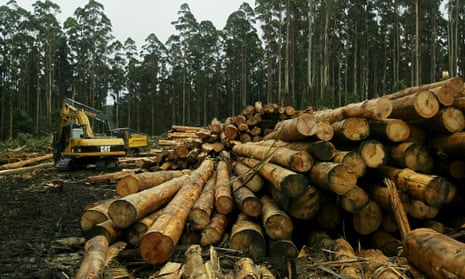Melbourne’s water supply is at risk because decades of logging and forest loss from large bushfires has triggered the imminent collapse of the mountain ash forests in Victoria’s central highlands, ecologists have said.
The Victorian government was warned of the likelihood of ecosystem collapse by Australian National University researches in 2015. New research led by Prof David Lindenmayer of ANU, published in PNAS journal on Tuesday, has found the ecosystem has already begun to undergo a “hidden collapse”.
Sign up to receive the top stories from Guardian Australia every morning
A hidden collapse meant that while the ecosystem may appear superficially intact, the lag time in recovering old-growth mountain ash forests — the linchpin in preserving mountain ash ecosystems — “means that collapse is almost inevitable”.
Even if there were no additional logging and no significant bushfires for the next 50 years, modelling by Lindenmayer and his co-author, Chloe Sato, showed the number of hollow-bearing trees in 2067 would be at best less than 10% than the number of hollow-bearing trees in 1997.
The number of hollow-bearing trees had already more than halved since 1997, the modelling showed, while numbers of greater glider had declined 65% and numbers of critically endangered Leadbeater’s possum had halved.
Guardian Australia revealed this month that the Victorian forest agency VicForests had begun logging Barjag Flat, a nationally significant hotspot for greater gliders.
Lindenmayer said if drastic measures were not immediately taken to halt or greatly reduce native logging operations in mountain ash forests, the forest may not be able to recover from the level of projected collapse in 2067 and would instead be replaced by an open acacia woodland.
Either option — a young and growing mountain ash forest or an acacia woodland — would be potentially disastrous for Melbourne’s water supply, he said.
The majority of Melbourne’s water catchments are in mountain ash forests, which are either protected in national parks or in state forests where logging is either allowed or has previously occurred.
If those forests have been damaged or are still growing, Lindenmayer said, they draw 12 megalitres more water per hectare per year than forests that are more than 100 years old.
More than 98% of the mountain ash forest in Victoria is no more than 80 years old, and most of those in key catchment areas are less than 80.
In the Upper Thomson catchment, which feeds Melbourne’s largest water supply dam, the Thomson reservoir, about 61% of the trees have been logged.
“That’s a serious issue because two-thirds of all the rainfall in that catchment falls on one-third of the area and that’s the ash forest … that’s called an own goal,” Lindenmayer said.
“The value of the water that flows into the water catchments is about 25.5 times higher than the value of the timber cut from those same catchments.”
An economic analysis published by the Threatened Species Recovery Hub found that economic contribution of the water supply to the Victorian economy was $310m, compared with $12m from the native timber industry.
“My hope is that at some stage people will wake up and say, ‘Oh my god, that’s the water supply for 4.5 million Melburnians,’” Lindenmayer said. “Is it appropriate to compromise the water supply of soon-to-be Australia’s largest city?”
He said the situation would be worsened if the federal government introduced new Regional Forestry Agreements to replace the rolled-over short-term agreements, which are due to expire in March 2020.
“The new RFAs are going to be even more disastrous because what they will do is lock in a guaranteed level of saw long supply … which isn’t really sustainable,” he said. “The RFAs don’t take into account other values like water or tourism ... it’s nonsensical. It doesn’t make any sense to me.”
